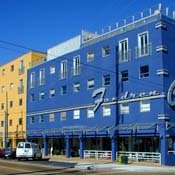Sept. 8, 2011
The Mississippi Development Authority is testing a program to beautify old strip malls and make them useful again. The Retail Center Revitalization Program will award grants of up to $50,000 to help community developers turn concrete eyesores into welcoming spaces.
At a summit to unveil the program Sept. 7, John Poros, director of the Carl Small Town Center at Mississippi State University, said strip malls became popular after World War II, but now the United States simply has too much retail space, especially with the rise of e-commerce luring many people to do their shopping online. Now, he said, communities are left with abandoned buildings without a shred of landscaping except for the grass growing through the cracks in the pavement out front. Shoppers today are looking for a pleasant experience, not just convenience, and that is what the Retail Center Revitalization Program aims to provide.
The pilot program will only award grants for about four projects to test its effectiveness. MDA is taking applications from planning and development districts that are working in partnership with local government and property owners. The cost of the project must be more than $100,000, and the strip center must be located on a main thoroughfare leading into a downtown area. Leland Speed, executive director of MDA, said renovated buildings could have a range of possible uses other than retail, such as medical centers, municipal offices or police stations.
At the summit, Mississippi developers shared success stories and ideas for the types of projects MDA is looking for. Mike Peters, owner of Peters Real Estate, shared how he transformed a vacant office building on State Street into Fondren Corner. The building now houses restaurants, boutiques, offices and apartments. Peters said cities should change their zoning regulations to allow for "mixed-use" developments that move living, recreational and work spaces closer together. That way, Peters said, people are in the area during all times of day, unlike a building of just offices that sits empty after business hours.
"I feel what makes this work is the whole mixed-use concept," Peters said. "This building has a life that none of these uses would have on its own. ... There's always something going on; there's never a dead time."
Joy Foy, director of asset development at MDA, said a project like Fondren Corner would not qualify for the grant because Fondren is considered in town instead of on a road leading into a downtown area. But she wanted people at the summit to see how Fondren Corner went from being just an office building to housing different types of tenants.
"You don't necessarily have to rebuild what's there; you can make it something new and something different," she said.
For information, email [e-mail missing] or visit MDA's website.


